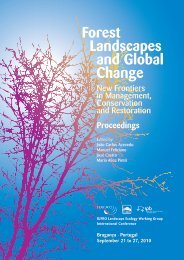Programa e Resumos - I Congresso Ibérico de Ciência do Solo 2004
Programa e Resumos - I Congresso Ibérico de Ciência do Solo 2004
Programa e Resumos - I Congresso Ibérico de Ciência do Solo 2004
You also want an ePaper? Increase the reach of your titles
YUMPU automatically turns print PDFs into web optimized ePapers that Google loves.
I <strong>Congresso</strong> Ibérico da Ciência <strong>do</strong> <strong>Solo</strong> – 15 a 18 <strong>de</strong> Junho <strong>de</strong> <strong>2004</strong>, Bragança, Portugal<br />
Evaluación <strong>de</strong> la estabilidad estructural <strong>de</strong>spués <strong>de</strong>l manejo <strong>de</strong> plantas <strong>de</strong><br />
cobertura en <strong>do</strong>s sistemas <strong>de</strong> laboreo (Matto Grosso <strong>do</strong> Sul, Brasil).<br />
Maria Merce<strong>de</strong>s Taboada Castro 1 , Marlene Cristina Alves 2 & Joann Whalen 3<br />
1 Universidad <strong>de</strong> A Coruña, Facultad <strong>de</strong> Ciencias, Campus <strong>de</strong> A Zapateira, 15071, A Coruña,<br />
España Telef: 34-981-167000– Correo electrónico: merche@mail2.udc.es<br />
2 Universida<strong>de</strong> Estadual Paulista “Julio Mesquita Filho”,Faculta<strong>de</strong> <strong>de</strong> Engenharia, Dpt,<br />
Fitossanida<strong>de</strong>, Engenharia Rural e <strong>Solo</strong>s. Campus <strong>de</strong> Ilha Solteira, SP-Brasil. – Tel: (+55) 18-<br />
3743-1143 – E-mail: mcalves@agr.feis.unesp.br<br />
3 McGill University. Faculty of Agricultural and Environmental Sciences. Dpt. of Natural<br />
Resource Sciences. Mac<strong>do</strong>nal Campus. Tel: (514) 398-7890 – E-mail: whalen@nrs.mcgill.ca<br />
Resumen<br />
Comunicación: Panel<br />
Los suelos bajo uso agrícola, <strong>de</strong>pendien<strong>do</strong> <strong>de</strong>l manejo a que son someti<strong>do</strong>s, pue<strong>de</strong>n<br />
sufrir <strong>de</strong>gradación o recuperación <strong>de</strong> su estructura.<br />
Con el objetivo <strong>de</strong> evaluar el efecto <strong>de</strong> plantas <strong>de</strong> cobertura y <strong>de</strong>l manejo <strong>de</strong>l suelo sobre<br />
la distribución <strong>de</strong> tamaño <strong>de</strong> agrega<strong>do</strong>s estables en agua, se tomaron muestras <strong>de</strong> un<br />
oxisol en una parcela experimental <strong>de</strong>spués <strong>de</strong> varios años en las que se sucedieron<br />
cultivos <strong>de</strong> invierno (Phaseolus vulgaris L.) y verano (Glycine max) con la implantación<br />
<strong>de</strong> plantas <strong>de</strong> cobertura durante la primavera. Los tratamientos fueron los siguientes:<br />
siembra convencional, siembra directa y plantas <strong>de</strong> cobertura. Las plantas <strong>de</strong> cobertura<br />
seleccionadas fueron guandú (Cajanus cajan), crotalaria (Crotalaria juncea), mucuna<br />
(Mucuna aterrima), y milheto (Pennisettum americanum), a<strong>de</strong>más <strong>de</strong> vegetación<br />
espontánea <strong>de</strong>sarrollada en zonas <strong>de</strong> barbecho. Las muestras se tomaron <strong>de</strong>spués <strong>de</strong>l<br />
manejo <strong>de</strong> las plantas <strong>de</strong> cobertura a <strong>do</strong>s profundida<strong>de</strong>s (0-5 cm y 5-15 cm) y con cuatro<br />
repeticiones.<br />
Los agrega<strong>do</strong>s estables al agua se <strong>de</strong>terminaron por tamiza<strong>do</strong> en húme<strong>do</strong>. Se obtuvo la<br />
distribución <strong>de</strong>l tamaño <strong>de</strong> agrega<strong>do</strong>s para seis clases, a partir <strong>de</strong> agrega<strong>do</strong>s<br />
comprendi<strong>do</strong>s entre 6,35 y 4 mm.<br />
La fracción mayoritaria obtenida fue la <strong>de</strong> la clase superior a 4 mm manifestada tanto en<br />
los <strong>do</strong>s sistemas <strong>de</strong> manejo <strong>de</strong>l suelo, como en ambas profundida<strong>de</strong>s y tipos <strong>de</strong><br />
cobertura. El sistema <strong>de</strong> laboreo convencional presentó un mayor porcentaje <strong>de</strong><br />
agrega<strong>do</strong>s estables en agua en la clase <strong>de</strong> mayor diámetro (> 4 mm), oscilan<strong>do</strong> entre<br />
73,32 % y 60,79% frente al sistema <strong>de</strong> no-laboreo, cuyo porcentaje fue inferior (54,85%<br />
y 44,63 %). El horizonte más superficial (0-5 cm) mostró mayor estabilidad que en la<br />
profundidad <strong>de</strong> 5 a 15 cm.<br />
Consi<strong>de</strong>ran<strong>do</strong> la clase <strong>de</strong> mayor presencia obtenida en cada una <strong>de</strong> las plantas <strong>de</strong><br />
cobertura se obtuvo el siguiente gra<strong>do</strong> <strong>de</strong> estabilidad: guandú > crotalaria > milheto ><br />
mucuna > barbecho, en sistema convencional y milheto > mucuna > barbecho ><br />
crotalaria > guandú en sistema <strong>de</strong> no-laboreo, ambos en la profundidad <strong>de</strong> 0-5 cm. Por<br />
tanto, esta variabilidad no permitió establecer un efecto claro entre las plantas <strong>de</strong><br />
cobertura que más favorecen la agregación.<br />
– 124 –
















